The SWORD Model for Historical Analysis: The Jewish Insurgency in Mandatory Palestine - 1945-47
Tryce Hyman
Introduction – The SWORD Model as a Guide to Doctrine
During the 1980s, the U.S. Army tasked the Southern Command’s Small Wars Operations Research Directorate (SWORD) to utilize past precedent in small wars in devising a paradigm for improving future success in such conflicts.[i] The results of this task, the SWORD Model (also known as the “Manwaring Paradigm”), appeared in an article written by Max G. Manwaring and John T. Fishel within the pages of the academic journal Small Wars and Insurgencies in 1992.[ii] In brief, the SWORD Model was derived through an analysis of forty-three different insurgencies. Individuals with expertise in one or more of these conflicts were questioned on what the respondent considered significant to its outcome.
Through this process, seventy-two different variables were generated. In assessing the relevance of these variables, data was acquired through an ordinal scale questionnaire answered by individuals with appropriate experience and/or expertise to provide answers for each particular insurgency.[iii] Following factor analysis of the resultant data, Manwaring and Fishel employed probit analysis in order to predict the outcomes of their sample of forty-three insurgencies, as well as to test the SWORD Model against five other explanatory models.[iv] The results were, frankly, startling. The SWORD Model demonstrated an accuracy rate in its predictions of ninety-percent, beating out the next-most accurate model (the USSOUTHCOM Corollary), but nearly twenty percentage-points.[v] The SWORD Model identified a number of “most important variables,” designated by temporality, and presented in two tables (recreated below):[vi]
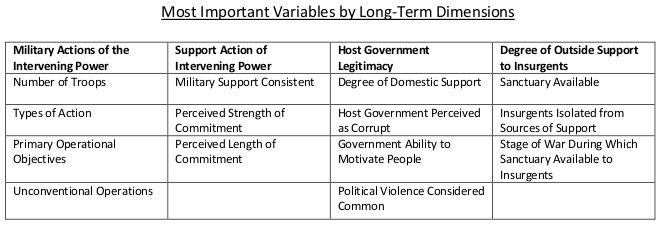
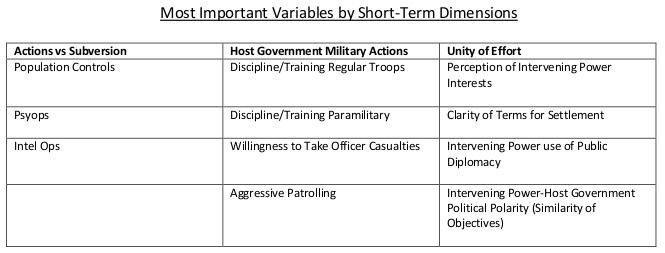
The variables either positively or negatively affect the outcome of a counterinsurgency based upon the how they manifest in a particular conflict.
Since its original publication, the SWORD Model has been elaborated on several times by Manwaring and Fishel, and additional insurgency cases have been added to its analysis.[vii] While the original purpose of the SWORD Model is to “outline a strong coherent conceptual framework or a set of principles from which doctrine, strategy, and tactics might flow—and, thus, to improve prospects for success in future counterinsurgency efforts,” a purpose for which it is capable of serving quite well, the SWORD Model can serve a secondary, yet valuable, purpose as a guide for historical analysis.
The SWORD Model in Historical Analysis: Making the Case
The SWORD Model, based as it is on a statistical representation of factors across a wide sample of historical insurgencies since the end of the Second World War, offers a real advantage over other historical analytical frameworks in approaching the subject of small wars and insurgencies.[viii] Because the SWORD Model’s entire framework is built upon the events of post-war insurgencies, it contains a natural capacity for use in historical analysis of conflicts that have remained politically charged in both their public discourse and their historiographies. The persistent state of discord as to what, in some cases, the facts even are in the historiography of certain conflicts veritably begs for what can be considered a more clinical framework for historical analysis.
This, the SWORD Model can provide, because it possesses no loyalty for any of the philosophical or narrative ontologies that consistently intrude on historical analyses of the very conflicts it models. These include such analytical perspectives as the modernist, the Marxist, the post-colonialist, the post-modernist, the revisionist, the Zionist, the post-Zionist, and on and on. Each of these analytical perspectives holds dear to itself a narrative-based ontology which it seeks to promote and defend—to the extent that historiography can and does often descend into polemics. The inherently statistical nature of the SWORD Model sidesteps these dangers. Indeed, the commitment of Manwaring and Fishel to the fidelity of their data led them to demand accuracy even when that accuracy might ruffle the feathers and sensibilities of their questionnaire respondents by having to admit to failure and defeat.[ix]
Adherents of certain analytical perspectives might object to the use of an analytical model commissioned by the military of (arguably) the world’s sole remaining hegemonic power for the purposes of defeating insurgencies to preserve its powers and interests. This is an obvious point, for which there is an equally obvious counterpoint: the SWORD Model is a statistical model which illustrates the systemic functions of counterinsurgency and insurgency—and as such is neutral in terms of policy in the same way that a parabola merely describes a thrown stone. Moreover, the SWORD Model is freely accessible over the internet, and thus lends itself equally to benefit insurgencies and those who seek to counter them.
Such assertions are, of course, insufficient on their own. The remainder of this study will illustrate use of the SWORD Model as a tool of historical analysis with a particular conflict as a case in point. Few, if any, sites of post-war conflict have generated so much public and historiographic contention as Israel/Palestine. This makes it a perfect testing ground for the SWORD Model as a framework of historical analysis. For our purposes, we will use the SWORD Model in examining the Jewish Insurgency in Mandatory Palestine.
Jewish Insurgency in Mandatory Palestine, Historiography, and the SWORD Model
Use of the SWORD Model in analyzing the Jewish Insurgency in Mandatory Palestine offers an opportunity to scrape away some six and a half decades of historiographic accretions on the matter. These accretions tend to be made up primarily of attributions of solitary cause as to the failure of the British during the insurgency, as well as political and moralistic commentaries on the conflict itself. These range from such claims as those asserting that it was chiefly the Irgun which drove the British out of Palestine, to others that insist the conflict between the British and the Jews in Mandatory Palestine was largely non-existent and that British failure in the Mandate owed entirely to the irreconcilable nature of Jewish and Arab national aspirations.[x]
Military histories, and histories of the foundation of the State of Israel, have, in general, displayed a tendency to overlook the Jewish Insurgency in Mandatory Palestine, or else to lump it into the 1948 War/Israeli War of Independence. While it is absolutely true that the two conflicts bled into each other, the Jewish Insurgency of 1945-1947 and the “civil war” beginning in 1947, which grew into the 1948 War/Israeli War of Independence, were two separate, though partially co-incident, conflicts. One particularly striking example of omission is Mordechai Bar-On’s 2004 edited volume A Never-ending Conflict: A Guide to Israeli Military History.[xi] The volume omits the Jewish Insurgency in Mandatory Palestine entirely, skipping from the end of the Arab Revolt in 1939 to the onset of the war in 1948. This is quite an omission for a volume that seeks to guide its readers through the historical development of the State of Israel’s military.
Within more general historiography, in addition to rolling the insurgency into the 1948 War, politicization is extraordinarily high. This is not surprising, as the Israel-Palestine conflict remains ongoing and shows little sign of resolving in the foreseeable future. The polarization of this historiography kicked into high-gear in the 1980s, when a group of scholars generally referred to as the “New Historians” began to challenge more classic Zionist historical narrative on everything from the insurgency and 1948 War, to the nature of Zionism itself. It is difficult to overstate the international controversy these scholars precipitated. For instance, Yoav Gelber’s discussion of the 1948 War in the volume mentioned above, A Never-ending Conflict: A Guide to Israeli Military History, is primarily a screed against the “New Historians,” some two decades on.
The relationship between the historiographic polemic surrounding the “New Historians” and propaganda campaigns such as that of the Irgun during the insurgency, is noteworthy. While Irgun propaganda was directed toward its purpose of gaining support for its insurgents, it also fell within a discourse of Jewish group promotion (which could be called propaganda, after a kind), that had been going on for at least a century before the Zionist movement, and has continued on into the present day—of which the “New Historians” and their opponents simply comprise a new development therein.[xii]
What little historiography there is since the 1980s dealing with the Jewish Insurgency directly has been influenced by the polemics of the “New Historians” controversy. For example, John Newsinger’s 2002 monograph (and its 2012 second edition), British Counterinsurgency from Palestine to Ireland, utilizes the work of “New Historians” in his short chapter on the insurgency.”[xiii] Such use is problematic, because the polemic therein makes useful analysis difficult if not impossible. In contrast, David A. Charters, in the monograph based on his doctoral dissertation, The British Army and Jewish Insurgency in Palestine, 1945-47, sidesteps this issue by avoiding the “New Historians” entirely—even though Charters completed his monograph while the controversy over the “New Historians” was generating enormous amounts of scholarship.[xiv] For this reason, Charter’s work is the one we will utilize most when we turn to the SWORD Model.
Notably, the Jewish Insurgency in Mandatory Palestine is subject to a bit of historical lumping even at the hands of the SWORD Model, within its appendix of sample conflicts:
Israeli War of Independence, 1945-1949.
- Participants: UK, Palestine Arabs, Jordan, Iraq, Syria, Egypt, Lebanon; Israeli nationalists, Irgun terrorists.
- Synopsis: Multi-faceted effort. Terrorist campaigns against Mandate power and each other. Ended with creation of Israel and Israeli defeat of invading Arab armies.[xv]
This lumping on the part of the SWORD Model may be a consequence of how the respondent in relation to this conflict, the British Army Historical Branch, kept records on the period.[xvi]
Whatever the case, for the purposes of this exercise, our SWORD Model-based historical analysis will be specifically focused upon the Jewish Insurgency of 1945-47. Filling in the myriad variables within the SWORD Model with the appropriate data on the conflict is quite revealing, as we shall see. Not only does this process do much to parse the reality behind the various conflicting historical narratives on the matter, it also offers novel insight as to the failure of this counterinsurgency in a historically meaningful way.
The Jewish Insurgency through the SWORD Model and Ambiguity
Coding the seventy-two SWORD Model variables paints a spectacularly bleak outlook for the likelihood that the Jewish Insurgency in Mandatory Palestine could have been defeated. Of the variables, sixty-three code negatively for counterinsurgency success. A listing of these variables and their coding is provided at the end of this study. Moreover, of those variables designated as most important within the SWORD Model, all code negatively:
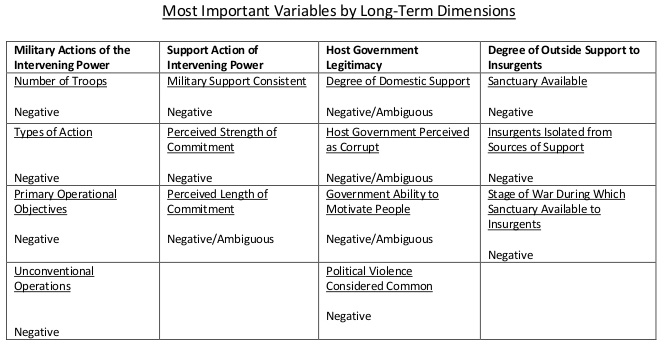
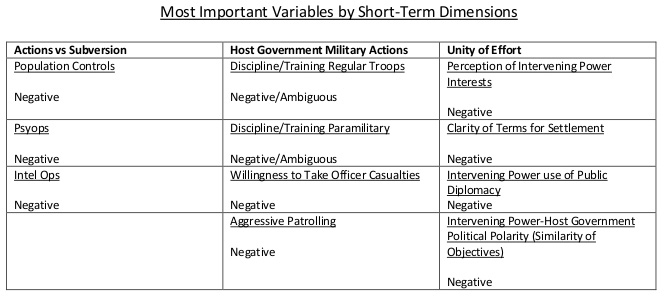
Given the spectacular confluence of negatively coding variables in regard to British counterinsurgency praxis during the Jewish Insurgency, a SWORD Model-based monograph fleshing out all of the particulars is ripe for the writing. For our own purposes of utilizing the SWORD Model in historical analysis, however, we turn to the ambiguities its use reveals about the Jewish Insurgency. Note that in the above tables, five of the most important variables are given the additional designation of “ambiguous.” Of the seventy-two variables used by the SWORD Model, twenty-one in total carry this designation[xvii].
These ambiguities are important and tend to arise where the interface and designation between Host Government and Intervening Power come into question. An elaboration of these ambiguities reveals systemic problems within the formation of the Mandate for Palestine. Succinctly, ambiguities arise from the fact that the Jewish Agency was designated as a legitimate and integral governing body by Article 4 of the Mandate for Palestine.[xviii] This simple fact causes strange things to happen with the SWORD Model variables within particular time contexts. Since Palestine was meant to be held in trust by the British, it often qualified as the intervening power on behalf of the Jewish Agency as host government.[xix] Within the insurgency, this would apply in certain cases, such as when Irgun terrorist activities were actively being opposed by both the British and by the Jewish Agency’s Haganah paramilitary force.[xx] Sometimes this took the form of the Haganah actively combating Irgun and Lehi, such as during the first and second “saisons,” while other times it took the form of the Haganah merely passing information on the whereabouts of Irgun members to the British.[xxi]
On the other hand, there were times where the Jewish Agency and Haganah at the very least tacitly supported insurgency, or in fact were the insurgency.[xxii] While there were myriad incidents where the Haganah engaged in destructive sabotage, it joined forces with the Irgun and Lehi outright during the United Resistance Movement of 1945-46.[xxiii] At such times, the insurgent desire to drive the British out of the Mandate, or else radically alter its Jewish immigration policy, shifted the classification of the British to that of the host government and the intervening power.[xxiv] In such instances, the entire Jewish population of Mandatory Palestine shifted into insurgency, even those working directly for the British Mandatory government—as evidenced by the information sieve the government became during these times through Jewish officials.[xxv] All of this was in addition to the Haganah’s ceaseless violation of British immigration policies, itself an insurgent practice, most dramatically in the incident with the Exodus.[xxvi]
As a side note, this ambiguity is equally pronounced outside of the context of the Jewish Insurgency itself. During the Arab Revolt of 1936-39, the Haganah came to the aid of the British in suppressing Arab insurgents—causing an instance in which the British were the host government and the Jewish Agency was the intervening power.[xxvii] Ambiguity mixes with irony in this instance, given that it was the involvement of the Jewish paramilitary groups in this earlier conflict that forged these groups into formidable forces. The Haganah worked with and received counterinsurgency training from the British officer Orde Charles Wingate.[xxviii] The lessons learned by the Haganah from Wingate in the “Special Night Forces” jointly deployed against insurgents of the Arab Revolt would disseminate through the Jewish paramilitary groups and inform their own later insurgency, described as one of the most effective terror campaigns in history.[xxix]
It may be impossible to overstate the counterinsurgency problems inherent to a situation where the Jewish Agency as host country government was to a greater or lesser extent insurgent against its own intervening power.[xxx] Additional ambiguity is manifest in the relationship between the Irgun and the Jewish Agency. Ultimately, their disagreement was one of methods, but despite this, the Irgun did not waiver in its sense of the Jewish Agency’s legitimacy as a governing body for the Jews of Palestine.[xxxi] The Jewish Agency clearly did not wish to entirely defeat the Irgun, it merely wanted to change its methods when they were a political liability—this is evidenced by the fact that the Jewish Agency was quite willing to have the Irgun act on behalf of Jewish interests when it felt the Haganah could not.[xxxii]
Issues such as these, owing to the nature of the Mandate, made fighting the Jewish Insurgency impossible for the British. This was chiefly because the Mandate called for the continuation of the Jewish Agency as the governing body of the Jews in Palestine.[xxxiii] Even the limited movement against the Jewish Agency during the United Resistance Movement, limited to seizure of supplies and the arrest of some of its leadership, was taken with reluctance by the British. While doing away with the Jewish Agency was at times considered, the idea never gained traction.[xxxiv] This is not surprising, as such a move would have effectively unmade the Mandate and delegitimized the British in the eyes of the Jews entirely—a problem which the British were unable to solve with Arabs during the Mandate. Bizarrely, even had the British disbanded the Jewish Agency, it would have been an insurgent victory by causing an international crisis sufficient to bring the Mandate itself to an end.
In this way, it may be inappropriate to question what the British may have done differently to succeed in its counterinsurgency. In the ambiguity of its relationship with the Jewish Agency, the British were essentially on their own, without the cooperation of a host government—and were left with the option of deposing said elected government, one the Mandate tasked them with supporting, as the only possible means of ending the insurgency. The British clearly had neither the means nor the will to do so, to even speak of the substantial financial and political resources abroad operating on behalf of the Jews of Palestine.[xxxv] Indeed, these ambiguities typified the relationship between the British and the Jewish Agency even outside the context of the insurgency of 1945-47. This was perhaps best summed up during the Second World War by David Ben Gurion’s declaration that he would oppose both the 1939 White Paper restricting Jewish immigration and the Axis Powers, each as though the other did not exist.[xxxvi] Frankly, though it lies beyond the scope of the present study, running the insurgency of 1945-47 through the SWORD Model strongly implies that the overall relationship between the British and the Jewish Agency during the course of the Mandate was existentially one of intervening power/host government/insurgent co-incidence and ambiguity. This suggests that the Mandate as a whole was systemically flawed beyond its own basic functionality.
Some Conclusions: Moderation of Historiographic Narrative
Use of the SWORD Model in analysis of the Jewish Insurgency in Mandatory Palestine of 1945-47 has illustrated fundamental ambiguities which rendered effective British counterinsurgency impossible and has offered a novel insight into the systemic impossibility of the British Mandate as an executable institution. Both offer welcome and needed moderation of the various controversies among the historiographic narratives which continue to mire scholarship related to both the Jewish Insurgency and the 1948 War/Israeli War of Independence more generally.
For instance, while it may be true that the activities of the Irgun gutted the resolve of the British to retain the Mandate, through their terror campaign and ultimately the reprisal hangings of two British sergeants, the Irgun (and Lehi) would not have been able to operate at all without the consistent support—in principle if not always in methods—of the Jewish Agency.[xxxvii] This consistent, though not always public, support from the Jewish Agency made it impossible to engage in any of the population controls that could have isolated the Irgun and Lehi—and usually meant that the British couldn’t even find them unless led by the hand via the Haganah.
Similarly, the “New Historian” challenge of the classic Zionist narrative of trenchant British opposition to the Zionist enterprise—which their own narrative argues was in fact trenchant British support despite inflammatory Jewish behavior—are not as mutually exclusive as the proponents of each narrative insist. Rather, the nature of the British Mandate meant that the British and the Jewish Agency were simultaneously co-dependent and at odds. This carries through the overall controversy between these two historiographic camps—which boils down to the status of the nature of the Jewish Agency as either a lawful body or a criminal organization. The results of our SWORD Model analysis demonstrate that the Jewish Agency was both.
It is also notable that the implication derived from the SWORD Model analysis that the British Mandate was systemically impossible to execute largely obviates grander historiographic assessments that the British failed in Palestine because of the irreconcilable natures of both Jewish and Arab nationalism. While these nationalisms were almost certainly irreconcilable, as an order of consequence, the systemic flaws take precedence – which is to say that the Mandate would have failed even in the absence of Arab national aspirations.
The preceding study has illustrated that the SWORD Model possesses useful functionality in historical analysis, especially in cutting through the historiographic polemics of conflicts which remain contentious. Even this study’s cursory use of the SWORD Model, for the purposes of demonstration and proof of concept, has shed useful light on the Jewish Insurgency in Mandatory Palestine of 1945-47 and its temporal environs. Moving forward, the SWORD Model shows great promise as a tool for historical analysis in addition to its intended design as a guide to counterinsurgency doctrine.
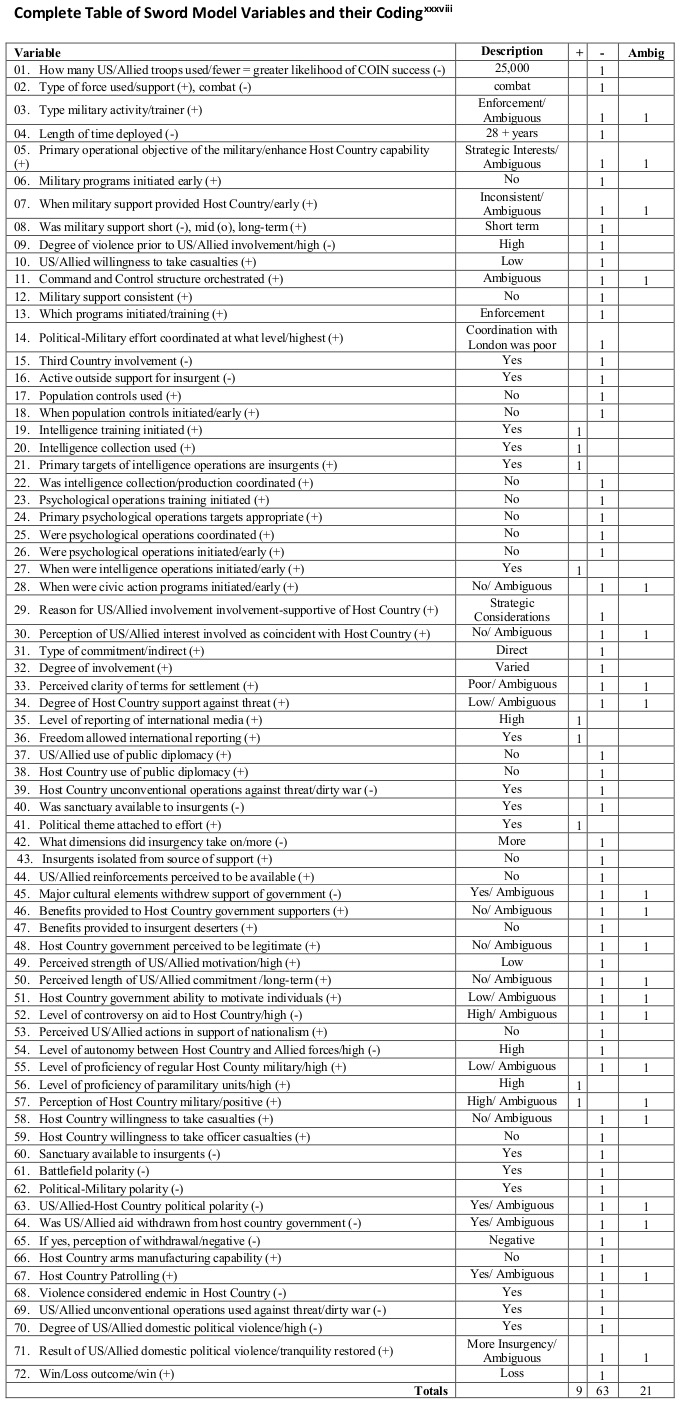
Complete Table of Sword Model Variables and their Coding[xxxviii]
End Notes
[i] John T. Fishel and Max G. Manwaring, Uncomfortable Wars Revisited, with a foreword and afterword by Edwin G. Corr (Norman: University of Oklahoma Press, 2006), 4.
[ii] Max G. Manwaring and John T. Fishel, “Insurgency and Counter-Insurgency: Toward a New Analytical Approach,” Small Wars and Insurgencies 3.3 (1992): 272-310.
[iii] Ibid., 276.
[iv] Ibid., 278; The five other models against which the SWORD Model were tested: the USSOUTHCOM Corollary, the SSI Stage 1 Model, the CIA Model, the Thompson’s Model, and the USSOUTHCOM Model.
[v] Ibid., 279.
[vi] Ibid., 284; recreation of Table 7 and Table 8.
[vii] See: Fishel and Manwaring, Uncomfortable Wars Revisited; John T. Fishel and Max G. Manwaring, “The SWORD Model of Counterinsurgency: A Summary and Update,” Small Wars Journal (2008), Online Journal, http://smallwarsjournal.com/jrnl/art/the-sword-model-of-counterinsurgency
[viii] Manwaring and Fishel, “Insurgency and Counter-Insurgency,” 273.
[ix] Ibid., 277.
[x] Examples: Saul Zaka, Blood in Zion: How the Jewish Guerrillas Drove the British out of Palestine, (London: Brassey’s, 1995); Tom Segev, One Palestine, Complete: Jews and Arabs Under the Mandate, (New York: Metropolitan Books, 2000).
[xi] Mordechai Bar-On, A Never-ending Conflict: A guide to Israeli Military History, (Westport: Praeger, 2004); Other military histories which sidestep the Jewish Insurgency includes: Zeev Moaz, “Rivalry and State Support of Non-State Armed Groups (NAGs), 1946-2001,” International Studies Quarterly 56 (2012): 720-734; Zeev Moaz, Defending the Holy Land: A Critical Analysis of Israel’s Security and Foreign Policy, (Ann Arbor: University of Michigan Press, 2006); Max Boot, Invisible Armies: An Epic History of Guerrilla Warfare from Ancient Times to the Present, (New York: Liveright, 2013).
[xii] Zaka, Blood in Zion, 100-123; The issue at hand for the “New Historians,” their opponents, and the Irgun’s propaganda, is the perception and place of Jews/Israel in the world at large. For a discussion of the historical continuity represented within the “New Historians” controversy, see: Tryce Hyman, “Israel’s New Historians and the Identity Discourse of the Wissenschaft des Judentums,” Presented at the Oklahoma Regional Conference of Phi Alpha Theta and the Sixty-Eighth Annual Meeting of The Oklahoma Association of Professional Historians, 2016, (Online), https://www.academia.edu/30362483/Israel_s_New_Historians_and_the_Identity_Discourse_of_the_Wissenschaft_des_Judentums
[xiii] John Newsinger, British Counterinsurgency From Palestine to Ireland, (New York: Palgrave, 2002); For a much newer volume that touches on the Arab Revolt and the Jewish Insurgency, but from a perspective that favors the “New Historians’” opponents, See: Matthew Hughes, “Colonial Rebellion and Counterinsurgency in Palestine: British Pacification of the Jewish and Arab Revolts, 1936-48,” in A History of Counterinsurgency, edited by Gregory Fremont-Barnes, 84-102, (Santa Barbara: Praeger, 2015).
[xiv] David A. Charters, The British Army and Jewish Insurgency in Palestine, 1945-1947, (New York: St. Martin’s Press, 1989).
[xv] Manwaring and Fishel, “Insurgency and Counter-Insurgency,” 295, Appendix I, entry 3.
[xvi] Ibid., 304. Notably, the listing in Appendix III, entry 3, lists the dates as ranging from 1945-48—at odds with the listing in Appendix I. A manuscript error appears to be at work here, though it is unclear if that error is in Appendix I or Appendix III.
[xvii] See table at end of paper.
[xviii] Charters, The British Army and Jewish Insurgency in Palestine, 1945-1947, 96.
[xix] Matthew Hughes, “Colonial Rebellion and Counterinsurgency in Palestine,” 84. The British intervened to protect Jews from Arab rioters on numerous occasions during the 1920s and early 1930s.
[xx] Zaka, Blood in Zion, 52-56.
[xxi] Ibid., 52; Charters, The British Army and Jewish Insurgency in Palestine, 1945-1947, 53. “Saison” is shorthand for “hunting season.”
[xxii] Charters, The British Army and Jewish Insurgency in Palestine, 1945-1947, 42.
[xxiii] Ibid., 57.
[xxiv] Ibid., 60-65.
[xxv] Ibid., 160.
[xxvi] Boot, Invisible Armies, 325.
[xxvii] Ibid., 294.
[xxviii] Ibid.
[xxix] Ibid., 295-296, 325.
[xxx] See: Fishel and Manwaring, Uncomfortable Wars Revisited, 162. In this update of the SWORD Model, the dimension Unity of Command is softened to Unity of Effort, to account for the growing prevalence of coalition operations. It is tempting to view the matter as a Unity of Effort problem, but the fact of Jewish Agency insurgency against its own IP pushes even the concept of Unity of Effort beyond its limits – it is likely impossible to fully reconcile the mutual status of the Jewish Agency as Host Government and Insurgency within any explanatory framework.
[xxxi] Zaka, Blood in Zion, 51.
[xxxii] Charters, The British Army and Jewish Insurgency in Palestine, 1945-1947, 60.
[xxxiii] Ibid., 96.
[xxxiv] Ibid.
[xxxv] Ibid., 28, 46, 67-8, 74-5.
[xxxvi] Ibid., 25.
[xxxvii] Ibid., 74; Zaka, Blood in Zion, 78.
[xxxviii] Manwaring and Fishel, “Insurgency and Counter-Insurgency,” 301-304. Variables taken from Appendix II—columns for coding: Description; + (positive); - (negative); Ambig(uous); added by author.
